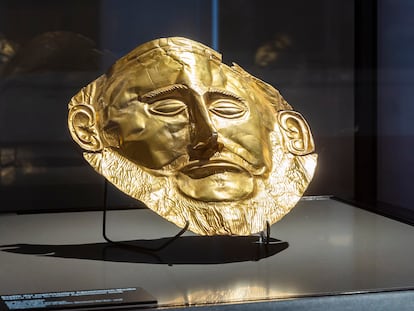Human skulls, Tudor shoes: A history of London through objects found in the mud of the Thames
Lara Maiklem is a mudlarker, one of the people who search the banks of the river in search of objects
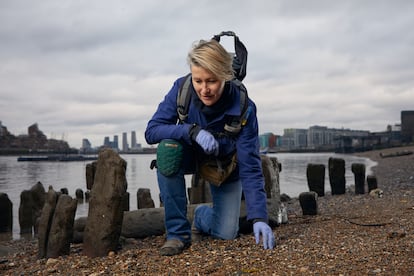

Lara Maiklem, 52, has seen at least three corpses floating in the Thames. She has also come across many other human remains from bygone times – tibias, skulls, jaws with teeth still attached, once belonging to people who fell from ships, who died in battles, who took their own lives or who were thrown in by someone who wanted to get rid of them. Maiklem once found a skull near the estuary which she named Fred: it was 300 years old and probably belonged to a prisoner confined somehwere in the area.
But that’s not what Maiklem’s work is about, Rather, it is about finding objects that testify to the past of a city as populous and with such a long history as London, in the river that runs through it. “The river is omnipresent in London, but sometimes we don’t seem to even see it,” explains Maiklem, who has written a book about her experiences, Mudlark: In Search of London’s Past Along the River Thames, now out in Spanish as well.
In it, she recounted her adventures and discoveries as a mudlarker, one of those diggers who take advantage of the low tides (the Thames is a tidal river) to scrutinize the mud and find objects from other eras. “People love it, because we all have a hunter-gatherer inside us,” she says. “It’s about the excitement of finding something you weren’t expecting.”
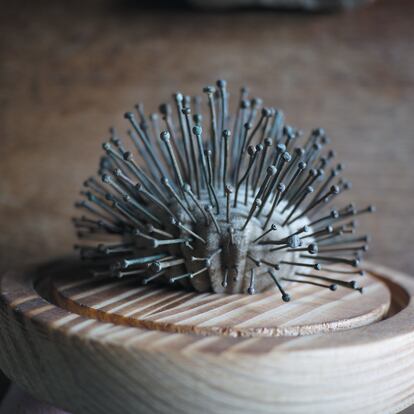
Mudlarking has historically been an activity performed by the lower classes of society. “It has existed since there were people so poor as to go looking for what other people throw away. The term began to be used at the end of the 18th century, alluding to people who lived on the fringes of society. It was a way of survival, but now it has become a hobby,” says the author, who has popularized the activity on social media under the name The London Mudlark. Her book is also a reflection on the history of the city as well as “a love letter” to the river: “It’s a beautiful ugly place, like all of London, which is a bit of a badass,” she jokes.
Roman bottle stoppers, 19th-century movable type made from lead (the bookbinder T. J. Cobden-Sanderson dumped 500,000 pieces into the river in the Hammersmith area), Tudor-era bricks, a medieval pilgrim’s band, a 16th-century sword, a container from the Iron Age... the Thames is the longest archaeological bed in England: thousands of objects kept in museums come from its banks. For example, the famous Battersea Shield, a Celtic bronze piece dated between 350 and 50 BC, now kept in the British Museum. To start looking, would-be mudlarks are advised to consult old maps and go where there is, or has at some point been, human activity: warehouses, docks, workshops, bridges or wharves. That is why it is also common to find items of little value associated with everyday life: iron chains, wooden bowls, the handle of a copper frying pan, beads, keys, nails, pieces of string or the pegs of a musical instrument. “Personally, this list transports me to other times, and at the same time it is very familiar to me,” writes Maiklem, who in 2022 was elected a fellow of the Society of Antiquaries of London.
A history of the average person
Thus, in the mud of the Thames, the mudlarkers uncover the history of average people – not of kings, dynasties or great military campaigns, but of the ordinary citizens trying to survive by the river in an increasingly crazy city. One of the reasons why so many antiquities are being found, in addition to those that people threw into the water, is that in other times the waste was used to fill and buttress the retaining walls of the river and other structures. When these erode or are damaged or demolished, the pieces are released, as if they had been stored in the freezer of history.
There is legislation that regulates which items can be kept by mudlarkers and which have to be delivered to the Museum of London, which relies heavily on these finds. There are objects considered “treasures” by the State: for instance, they must be over 300 years old and at least 10% of their weight must be made up of precious metals, although there are other requirements as well. Of course, there is also a large amount of contemporary material in the waters, especially pertaining to hygiene or medicine: bath toys, combs, colostomy bags, syringes, toothbrushes. And one can also run into wastewater: the equivalent of 7,200 Olympic-sized swimming pools is dumped into the river every year. Today, the Thames is one of the cleanest city rivers in the world, but in the mid-20th century it was so dirty and neglected that it was considered “biologically dead,” until a recovery operation succeeded in getting it cleaned up.
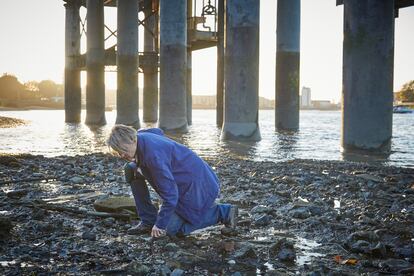
Not everyone can do it: to practice mudlarking you need a license. And to be a member of the distinguished Thames Estuary Mudlarkers Society, founded in 1962 by Harry Mostyn, curator of the National Maritime Museum, it is necessary to hold the standard license for two years and have made contributions to the Museum of London. There are those who use metal detectors and who dig holes in the ground, but Maiklem is not in favor of this last practice, because it can seriously damage buried objects and the riverbank itself. She prefers simply to look at the surface, to take in what the river offers her with the naked eye.
Maiklem began practicing mudlarking when she moved to the capital from the family farm in Surrey in the early 1990s. As a restless young woman she was bored with the countryside and obsessed by the London lights and chaos. Once in London, the Thames was just an obstacle that she crossed, slumped in the back seat of a taxi when she returned, at dawn, from clubs and crazy parties. But one day she noticed it... and it felt good, like she was coming home.
In fact, Maiklem retains some of the skills she honed in the countryside: the supple back of a family used to picking potatoes, the full attention to small things that her mother instilled in her. Now, Maiklem pays close attention to what the riverside mud harbors and she has adapted her gaze to interpret it, just as scientists learn to interpret what they see under a microscope. In nature there are few straight lines, few perfect shapes, so detecting them in the mud is a way of recognizing what has been made by human hands.
The dangers of getting lost in the river
The practice of mudlarking has advantages: it is a way to develop patience in these rushed times, to relax and spend time away from the smartphone, to isolate yourself from the outside world, to practice mindfulness. But this lack of awareness about our surroundings can also be dangerous: “You have to be aware of the tide, which can rise quickly while you are distracted. And you also have to be careful in areas where the mud is very deep and you can sink in”, warns the expert.
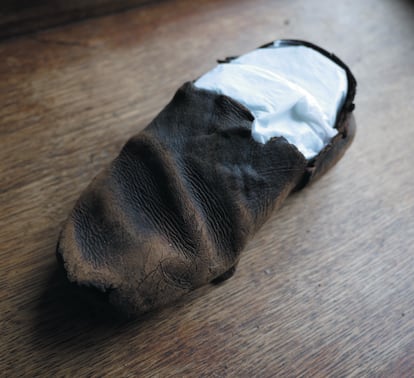
Sometimes Maiklem finds bottles with messages inside, children’s tales of dragons and princesses or intimate scribbles, farewells to loved ones who have gone forever or psychological demons that someone wants to conjure up by delivering them to the river as a therapy. The river also has a long magical, religious and spiritual past. “Sometimes searching the river is like reading people’s newspapers: love letters, old photographs, engagement rings turn up...” she says. The precious “witch bottles” also appear with some frequency: containers filled with urine, hair or fingernails that served to protect from hypothetical evil spells.
But Maiklem’s favorite find is a small boy’s shoe from the Tudor era, in the 16th century: “The mud preserves the fabrics as they were when they ended up in the river, so this shoe is perfectly preserved, you can see perfectly the shape of the toes of the child who used it, a hole where the big toe was, it’s like a trip back in time. For that feeling, for discoveries like this, it is worth spending hours and hours in the damp and cold searching the banks of the Thames.”
Sign up for our weekly newsletter to get more English-language news coverage from EL PAÍS USA Edition
Tu suscripción se está usando en otro dispositivo
¿Quieres añadir otro usuario a tu suscripción?
Si continúas leyendo en este dispositivo, no se podrá leer en el otro.
FlechaTu suscripción se está usando en otro dispositivo y solo puedes acceder a EL PAÍS desde un dispositivo a la vez.
Si quieres compartir tu cuenta, cambia tu suscripción a la modalidad Premium, así podrás añadir otro usuario. Cada uno accederá con su propia cuenta de email, lo que os permitirá personalizar vuestra experiencia en EL PAÍS.
¿Tienes una suscripción de empresa? Accede aquí para contratar más cuentas.
En el caso de no saber quién está usando tu cuenta, te recomendamos cambiar tu contraseña aquí.
Si decides continuar compartiendo tu cuenta, este mensaje se mostrará en tu dispositivo y en el de la otra persona que está usando tu cuenta de forma indefinida, afectando a tu experiencia de lectura. Puedes consultar aquí los términos y condiciones de la suscripción digital.
More information
Últimas noticias
Most viewed
- Sinaloa Cartel war is taking its toll on Los Chapitos
- Oona Chaplin: ‘I told James Cameron that I was living in a treehouse and starting a permaculture project with a friend’
- Reinhard Genzel, Nobel laureate in physics: ‘One-minute videos will never give you the truth’
- Why the price of coffee has skyrocketed: from Brazilian plantations to specialty coffee houses
- Silver prices are going crazy: This is what’s fueling the rally
